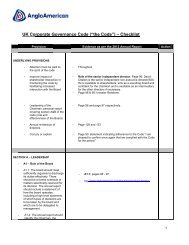Anglo American Annual Report 2012
Anglo American Annual Report 2012
Anglo American Annual Report 2012
- No tags were found...
You also want an ePaper? Increase the reach of your titles
YUMPU automatically turns print PDFs into web optimized ePapers that Google loves.
25. FINANCIAL RISK MANAGEMENT AND DERIVATIVES continuedDerivativesIn accordance with IAS 32 Financial Instruments: Presentation and IAS 39, the fair values of derivatives are separately recorded on the balance sheet within‘Derivative financial assets’ and ‘Derivative financial liabilities’. Derivatives are classified as current or non-current depending on the maturity of the derivative.The Group utilises derivative instruments to manage certain market risk exposures as explained above. The Group does not use derivative financialinstruments for speculative purposes, however it may choose not to designate certain derivatives as hedges for accounting purposes. Such derivatives areclassified as ‘non-hedges’ and fair value movements are recorded in the income statement.The use of derivative instruments is subject to limits and the positions are regularly monitored and reported to senior management.Embedded derivativesDerivatives embedded in other financial instruments or other host contracts are treated as separate derivatives when their risks and characteristics are notclosely related to those of their host contract and the host contract is not carried at fair value. Embedded derivatives may be designated into hedgerelationships and are accounted for in accordance with the Group’s accounting policy set out in note 1.Cash flow hedgesIn certain cases the Group classifies its forward foreign currency and commodity price contracts, which hedge highly probable forecast transactions, as cashflow hedges. Where this designation is documented, changes in fair value are recognised in equity until the hedged transactions occur, at which time therespective gains or losses are transferred to the income statement (or hedged balance sheet item) in accordance with the Group’s accounting policy set outin note 1.Fair value hedgesThe majority of interest rate swaps (taken out to swap the Group’s fixed rate borrowings to floating rate, in accordance with the Group’s policy) have been designatedas fair value hedges. The carrying value of the hedged debt is adjusted at each balance sheet date to reflect the impact on its fair value of changes in marketinterest rates. Changes in the fair value of the hedged debt are offset against fair value changes in the interest rate swap and classified within net finance costsin the income statement.Non-hedgesThe Group may choose not to designate certain derivatives as hedges. This may occur where the Group is economically hedged but IAS 39 hedge accountingcannot be achieved or where gains and losses on both the derivative and hedged item naturally offset in the income statement, which for example may be thecase for certain cross currency swaps of non-US dollar debt. Where derivatives have not been designated as hedges, fair value changes are recognised in theincome statement in accordance with the Group’s accounting policy set out in note 1 and are classified as financing or operating depending on the nature ofthe associated hedged risk.The fair value of the Group’s open derivative position at 31 December (excluding normal purchase and sale contracts held off balance sheet), recorded within‘Derivative financial assets’ and ‘Derivative financial liabilities’ is as follows:CurrentNon-current<strong>2012</strong> 2011 <strong>2012</strong> 2011US$ million Asset Liability Asset Liability Asset Liability Asset LiabilityCash flow hedgeForward foreign currency contracts 3 – 6 (1) – – – –Fair value hedgeInterest rate swaps 31 – – – 687 (6) 538 –Forward commodity contracts 1 (2) – (5) – – – –Non-hedge (‘Held for trading’)Forward foreign currency contracts 35 (124) 117 (121) – (1) 11 (33)Cross currency swaps 31 (124) 49 – 60 (781) 55 (908)Other – (30) – (35) – (13) 64 (9)101 (280) 172 (162) 747 (801) 668 (950)Financial statementsThese marked to market valuations are in no way predictive of the future value of the hedged position, nor of the future impact on the profit of the Group.The valuations represent the cost of closing all hedge contracts at year end, at market prices and rates available at the time.Normal purchase and normal sale contractsCommodity based contracts that meet the scope exemption in IAS 39 (in that they are settled through physical delivery of the Group’s production or are usedwithin the production process), are classified as normal purchase or sale contracts. In accordance with IAS 39 these contracts are not marked to market.Capital risk managementThe Group’s objectives when managing capital are to safeguard the Group’s ability to continue as a going concern in order to provide returns for shareholdersand benefits for other stakeholders and, with cognisance of forecast future market conditions and structuring, to maintain an optimal capital structure toreduce the cost of capital.In order to manage the short and long term capital structure, the Group adjusts the amount of ordinary dividends paid to shareholders, returns capital toshareholders (via, for example, share buybacks and special dividends), arranges debt to fund new acquisitions and may also sell non-core assets to reduce debt.<strong>Anglo</strong> <strong>American</strong> plc <strong>Annual</strong> <strong>Report</strong> <strong>2012</strong> 171



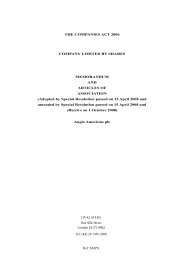
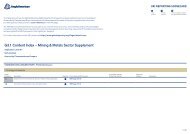
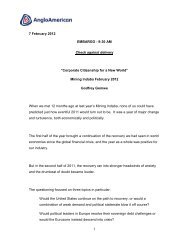
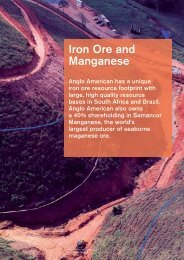
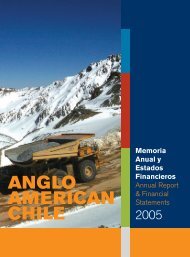
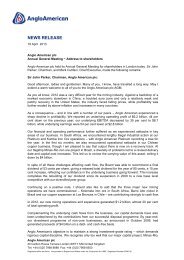
![English PDF [ 189KB ] - Anglo American](https://img.yumpu.com/50470814/1/184x260/english-pdf-189kb-anglo-american.jpg?quality=85)



![pdf [ 595KB ] - Anglo American](https://img.yumpu.com/49420483/1/184x260/pdf-595kb-anglo-american.jpg?quality=85)
![pdf [ 1.1MB ] - Anglo American](https://img.yumpu.com/49057963/1/190x240/pdf-11mb-anglo-american.jpg?quality=85)
